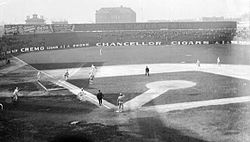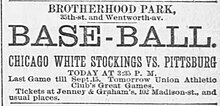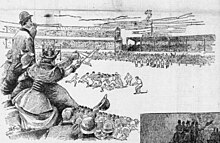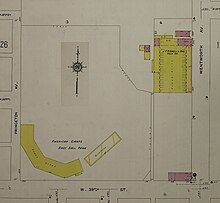
The Chicago White Sox are an American professional baseball team based in Chicago. The White Sox compete in Major League Baseball (MLB) as a member club of the American League (AL) Central Division. The team is owned by Jerry Reinsdorf, and plays its home games at Guaranteed Rate Field, located on Chicago's South Side. They are one of two MLB teams based in Chicago, alongside the National League (NL)’s Chicago Cubs.
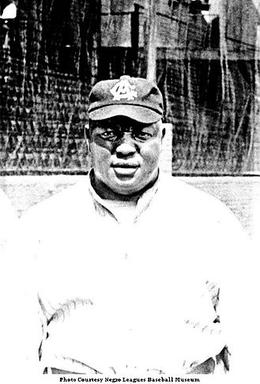
Andrew "Rube" Foster was an American baseball player, manager, and executive in the Negro leagues. He was elected to the Baseball Hall of Fame in 1981.

Comiskey Park was a ballpark in Chicago, Illinois, located in the Armour Square neighborhood on the near-southwest side of the city. The stadium served as the home of the Chicago White Sox of the American League from 1910 through 1990. Built by White Sox owner Charles Comiskey and designed by Zachary Taylor Davis, Comiskey Park hosted four World Series and more than 6,000 Major League Baseball games. The field also hosted one of the most famous boxing matches in history: Joe Louis' defeat of champion James J. Braddock, launching his 11-year run as the heavyweight champion of the world.

Charles Albert Comiskey, nicknamed "Commy" or "the Old Roman", was an American Major League Baseball player, manager and team owner. He was a key person in the formation of the American League, and was also founding owner of the Chicago White Sox. Comiskey Park, the White Sox's storied baseball stadium, was built under his guidance and named for him.

The Cubs–White Sox rivalry refers to the Major League Baseball (MLB) geographical rivalry between the Chicago Cubs and Chicago White Sox. The Cubs are a member club of MLB's National League (NL) Central division, and play their home games at Wrigley Field, located on Chicago's North Side. The White Sox are a member club of MLB's American League (AL) Central division, and play their home games at Guaranteed Rate Field, located on Chicago's South Side.
23rd Street Grounds, also known as State Street Grounds and 23rd Street Park, and sometimes spelled out as Twenty-third Street Grounds, was a ballpark in Chicago, in what is now the Chinatown district. In this ballpark, the Chicago White Stockings played baseball from 1874 to 1877, the first two years in the National Association and the latter two in the National League.
Union Base-Ball Grounds was a baseball park located in Chicago. The park was "very visibly downtown", its small block bounded on the west by Michigan Avenue, on the north by Randolph Street, and on the east by railroad tracks and the lake shore, which was then much closer than it is today. The site is now part of Millennium Park.

West Side Park was the name used for two different ballparks that formerly stood in Chicago, Illinois. They were both home fields of the team now known as the Chicago Cubs of the National League. Both ballparks hosted baseball championships. The latter of the two parks, where the franchise played for nearly a quarter century, was the home of the first two world champion Cubs teams, the team that posted the best winning percentage in Major League Baseball history and won the most games in National League history (1906), the only cross-town World Series in Chicago (1906), and the immortalized Tinker to Evers to Chance double-play combo. Both ballparks were primarily constructed of wood.
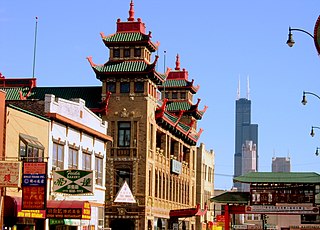
Armour Square is a Chicago neighborhood on the city's South Side, as well as a larger, officially defined community area, which also includes Chinatown and the CHA Wentworth Gardens housing project. Armour Square is bordered by Bridgeport to the west, Pilsen to the northwest, Douglas and Grand Boulevard to the east and southeast, and with the Near South Side bordering the area to the north, and Fuller Park bordering its southernmost boundary, along Pershing Road.
The Chicago American Giants were a Chicago-based Negro league baseball team. From 1910 until the mid-1930s, the American Giants were the most dominant team in black baseball. Owned and managed from 1911 to 1926 by player-manager Andrew "Rube" Foster, they were charter members of Foster's Negro National League. The American Giants won five pennants in that league, along with another pennant in the 1932 Negro Southern League and a second-half championship in Gus Greenlee's Negro National League in 1934.
The Chicago Browns/Pittsburgh Stogies were a short-lived professional baseball team in the Union Association of 1884. They were to battle the Chicago White Stockings, of the National League, for the Chicago baseball market; however, the Browns lost that battle to the White Stockings. After a Baltimore mattress maker gave the club a degree of financial support, the Browns then tried to entice the White Stockings' Larry Corcoran, one of the 1880s top pitchers, to join the team. However, the club did not succeed in doing so. The Chicago Browns disbanded after a game on August 22, 1884. The club then moved to Pittsburgh and became the Stogies, which disbanded after a game played on September 18, 1884. Many of the club's players then joined the Baltimore Monumentals. Altogether, they won 41 games, lost 50, and tied 2, finishing sixth in the twelve-team league.
Madison Avenue Grounds was a baseball ground located in Baltimore, Maryland. It was built by the Waverly Club as the first enclosed ballpark in Baltimore, with spectator seating and player clubhouses, and was the site of the first intercity game played in Baltimore on September 22, 1860; it was the site of a 47-7 defeat of the local Marylands by the undefeated Cincinnati Red Stockings in 1869, and it was used by the Washington Olympics for a professional game in 1871. On August 16, 1870, it was the site of an intercity game between black teams. It would continue to be used for games staged by black teams, in a time before there were any organized Negro leagues.

The Leland Giants, originally the Chicago Union Giants, were a Negro league baseball team that competed independently during the first decade of the 20th century. The team was formed via a merge of the Chicago Unions and the Chicago Columbia Giants in 1901, and then split in 1910 to form the Chicago Giants and what would become known as the Chicago American Giants. The team was named after its owner and manager, Frank Leland.
